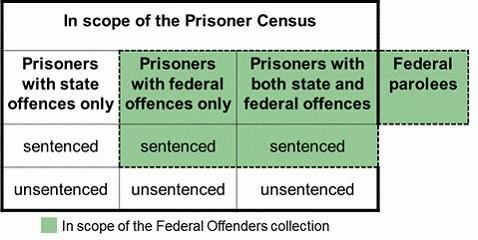Scope
The scope of the statistics in this publication includes all persons remanded or sentenced to adult custodial corrective services agencies in each state and territory in Australia.
Included in the National Prisoner Census are prisoners in the legal custody of corrective services who at the time of the census, were:
- absent on an authorised temporary leave permit except for Victoria and the Australian Capital Territory
- absent from the correctional facility on a work release permit or program
- located in secure wards in a hospital or mental health institution outside the correctional facility administered under Corrective Services departments
- periodic detainees until 2016
- serving post-sentence detention orders.
Excluded from the collection are:
- prisoners who were unlawfully absent from corrective services legal custody, e.g. escapees or prisoners who failed to return from an authorised temporary absence from a correctional facility
- prisoners whose legal custody had been transferred to another agency, e.g. police or mental health institutions
- prisoners who were retained at court at the time of the census are excluded from the data.
Types of facilities
The types of correctional facilities and programs where prisoners are held vary between the states and territories.
Included in the collection are:
- gazetted adult prisons in all jurisdictions
- periodic detention centres in the Australian Capital Territory until 2016
- work camps in Queensland, Western Australia and the Northern Territory
- cells in court complexes administered by corrective services in New South Wales
- transitional centres in New South Wales and Victoria
- gazetted police prisons in the Northern Territory which are administered and controlled by the Director of Corrective Services
- police lock-ups under SA Corrective Services department
- mental health facilities administered under Corrective Services departments
Excluded from the collection are persons held in facilities administered and controlled by other agencies:
- police lock-ups, police prisons and cells in court complexes
- immigration detention centres
- home detention programs
- military prisons
- mental health facilities administered under health departments
- juvenile facilities, including those under the authority of adult corrective services
Age
From 2019, in all states and territories persons remanded or sentenced to adult custody are aged 18 years and over. Persons under 18 years are treated as juveniles in most Australian courts and are only remanded or sentenced to custody in adult prisons in exceptional circumstances. In Queensland, prior to 2018, 'adult' referred to persons aged 17 years and over. From February 2018 onwards, persons aged 17 years are being transitioned from adult correctional facilities into the Queensland juvenile justice system over a two-year period. In 2019, there were no 17 year-olds in Queensland adult correctional facilities.
Jurisdiction of custody
Persons included in the National Prisoner Census were counted in the state or territory in which they were held in custody regardless of which state or territory imposed the sentence being served.
Source
The statistics in this publication are derived from information held in administrative systems which are maintained by corrective services agencies within each state and territory.


